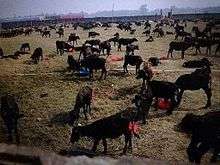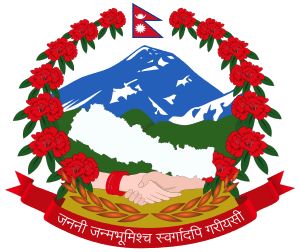Gadhimai festival
| Gadhimai festival गढ़िमाई पर्व | |
|---|---|
 Animals at Gadhimai festival | |
| Status | Ended |
| Genre | Festivals |
| Begins | 28 November 2014 |
| Frequency | every 5 years |
| Venue | Bariyarpur |
| Location(s) | Bara District |
| Most recent | 28 November 2014 |
| Previous event | 2009 |
| Next event | Ended |
| Attendance | 4 million people |
| Area | 3-5 km radius around the Gadhimai Temple |
Gadhimai festival was a sacrificial ceremony that was held every 5 years at the Gadhimai Temple of Bariyarpur, in Bara District, about 100 miles (160 km) south of the capital Kathmandu in the southern Nepal, near the Indo-Nepal border, adjacent to Bihar. It was primarily celebrated by the Madheshi and Bihari people. The event involves the large scale sacrificial slaughter of animals including water buffaloes, pigs, goats, chickens, and pigeons – with the goal of pleasing Gadhimai, the goddess of power.[1]
It is estimated that 50,000 animals were sacrificed during the Gadhimai festival of 2009. In 2015, Nepal's temple trust on announced to cancel all future animal sacrifice at the country's Gadhimai festival.[2][3]
Description
About 4 million people participate in the festival.[4][5] Participants believe that animal sacrifices to the Hindu goddess Gadhimai will end evil and bring prosperity.[6][7]
A month before the ritual in 2009, the Madheshi politicians realized there would be a "severe shortage" of goats for the ritual sacrifice, as well as for the consumption of goat meat during the festival. They began a radio campaign urging farmers to sell their animals.[8]
The festival started in the first week of November 2009 and ended in the first week of December (up to makar sankranti), the fair has a custom of animal sacrifice that occurred on November 24 & 25 in the year 2009, with the temple's head priest performing ritual sacrifice called Saptabali which includes the sacrifice of white mice, pigeons, roosters, ducks, swine and male water buffaloes. More than 20,000 buffaloes were sacrificed on the first day.[9] It is estimated that 250,000 animals were sacrificed during the Gadhimai festival of 2009.[10] The ritual killings were performed by more than 200 men in a concrete slaughterhouse near the temple.[11]
Controversies and objections

The festival has prompted numerous protests by animal rights activists and Nepalese Hindus from Hill region.[12][13] In 2009 activists made several attempts to stop the ritual, including Brigitte Bardot and Maneka Gandhi, who wrote to the Nepalese government asking them to stop the killings.[14][15] A government official commented that they would not "interfere in the centuries-old tradition of the Madheshi people."[4]
Ram Bahadur Bomjon, claimed by some of his supporters to be the reincarnation of the Buddha, said that he would attempt to stop the sacrifice at the festival, preaching non-violence and offering a blessing at the place.[16][17] His promise prompted the government to send additional forces to prevent any incident.[17]
After the festival, the meat, bones and hides of the animals are sold to companies in India and Nepal.[1]
In October 2014, Gauri Maulekhi (People for Animals Uttarakhand (PFA) trustee and Humane Society International (HSI) consultant) filed a petition against the illegal transportation of animals from India to Nepal for slaughter. After this, The Supreme Court of India passed an interim order directing the Government of India to prevent animals being illegally transported across the border for sacrifice at Gadhimai. The court also asked animal protection groups and others to devise an action plan to ensure the court order is implemented.[18]
NG Jayasimha, HSI India's MD, visited Nepal to ensure the ban is being adhered to. In an interview to the Times of India he said, "I am very pleased that we were able to sit down with the Nepali President, Prime Minister and other politicians, to speak up for the hundreds of thousands of innocent animals who are condemned to an utterly unjustified beheading at Gadhimai. We also spoke directly to the Gadhimai temple and the local magistrate, so they can be in no doubt of the overwhelming call for compassion. We sincerely hope that they will act to stop this unnecessary bloodshed".[18]
On July 28, 2015 this festival has been banned by the HSI India.[19] The Gadhimai Trust, an official entity of Gadhimai claims that they hadn't stopped the festival and nor they are allowed to stop the sacrifice.[20]
Reactions
The Indian Ministry of Home Affairs has directed the states of Bihar and Uttar Pradesh to monitor and make sure no animals get to Nepal for the festival.[21]
Termination of the festival
Nepal's temple trust announced the cancellation of all future animal sacrifice at the country's Gadhimai festival in July 2015.[22][23][24]
See also
References
| Wikinews has related news: Ritual sacrifice in Nepal sees 320,000 animals slaughtered to Hindu goddess |
- 1 2 Jolly, Joanna (24 November 2009). "Devotees flock to Nepal animal sacrifice festival". BBC. Retrieved 24 November 2009.
- ↑ Ram Chandra, Shah. "Gadhimai Temple Trust Chairman, Mr Ram Chandra Shah, on the decision to stop holding animal sacrifices during the Gadhimai festival:" (PDF). Humane Society International. Retrieved 29 July 2015.
- ↑ Meredith, Charlotte (29 July 2015). "Thousands of Animals Have Been Saved in Nepal as Mass Slaughter Is Cancelled". Vice News. Vice Media, Inc. Retrieved 29 July 2015.
- 1 2 "Gadhimai festival begins despite protests in Nepal". The Hindu. 24 November 2009. Retrieved 24 November 2009.
- ↑ Sarkar, Sudeshna (24 November 2009). "Indians throng Nepal's Gadhimai fair for animal sacrifice". The Times of India. Retrieved 24 November 2009.
- ↑ Gurubacharya, Binaj (20 November 2009). "Gadhimai Festival: Nepal Mass Animal Sacrifice Festival To Go Ahead Despite Protests". The Huffington Post. Retrieved 25 November 2009.
- ↑ "In pictures: Hindu animal sacrifice festival in Nepal". BBC News. Retrieved 28 November 2014.
- ↑ "Nepal hit by severe goat shortage". BBC. 15 September 2009. Retrieved 25 November 2009.
- ↑ "Over 20,000 buffaloes slaughtered in Gadhimai festival". NepalNews.com. 25 November 2009. Retrieved 25 November 2009.
- ↑ Lang, Olivia (24 November 2009). "Hindu sacrifice of 250,000 animals begins". The Guardian. Retrieved 6 December 2014.
- ↑ Xiang, Zhang. "Gadhimai festival begins in central Nepal". Xinhua News Agency. Retrieved 25 November 2009.
- ↑ Shah, Pramada (24 November 2010). "Never Again". The Kathmandu Post. Retrieved 20 March 2012.
- ↑ "Gadhimai Festival:Why it must never happen Again". Think Differently. Retrieved 18 March 2012.
- ↑ "Bardot appeal over animal slaughter at Nepal festival". BBC. 20 November 2009. Retrieved 25 November 2009.
- ↑ Bhanot, Anil (25 November 2009). "The Gadhimai sacrifice is grotesque". The Guardian. Retrieved 25 November 2009.
- ↑ "Sacrifice of 200,000 Animals Proceeds Despite Pleas, Prayers". Environment News Service. 22 November 2009. Retrieved 25 November 2009.
- 1 2 Lamichhane, Upendra (20 November 2009). "Buddha boy fails to turn up at Gadhimai". Republica. Retrieved 25 November 2009.
- 1 2 Sigdel, Chahana (20 November 2014). "India confiscates hundreds of animals at Nepal border ahead of Gadhimai festival". Times of India.
- ↑ "From now on, no more animal sacrifice at Nepal's Gadhimai festival". 28 July 2015.
- ↑ "'गढीमाईमा बलि नदिइने निर्णय छैन्'".
- ↑ Gohain, Manash Pratim (13 October 2014). "Gadaimai slaughter: Bihar, UP asked to check animal flow into Bara". Kantipur. Retrieved 29 November 2014.
- ↑ "Nepal chooses kindness — ENDING the world's largest animal sacrifice event".
- ↑ "Animal sacrifice banned during Nepal festival - Times of India".
- ↑ AFP (28 July 2015). "Nepal temple bans mass animal slaughter at festival" – via The Guardian.
